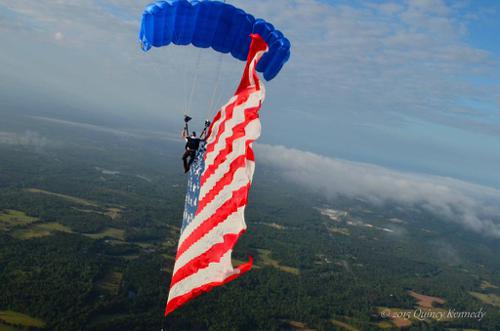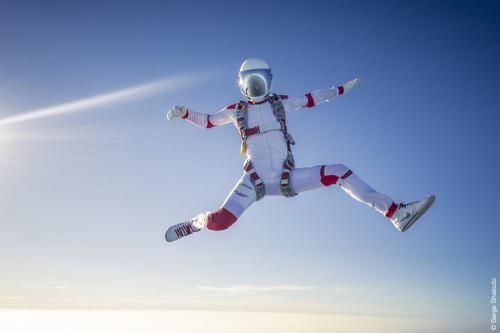“Misty” Kim Kanat Talks About the Team
Guess what? There’s been an all-female demo team kicking ass and taking names since the 1980s. Maybe you’re as surprised to learn about them as I was--or maybe you’re squinting at your screen and wondering what rock I’ve been hiding under--but y’know what? I think we can both agree that that’s pretty damn great.
The basics are pretty straightforward: The team of 13 women calls Skydive Tecumseh home, jumps hot-pink-and-navy kit and specializes in jumping big honkin’ flags. The details are the cool part: Each one of “the Mistys” can do anything the demo requires, from packing the flags to setting up the smoke--and each is a highly successful professional with a full-time career outside of skydiving.
When I visited Skydive Tecumseh to check off Michigan for Down for 50, I jumped at the chance to corner Misty member Kim Kanat and pick her brain about the team. During the week, Kim is a mild-mannered (and high-powered) Facility Manager for a real estate company; but, when the call comes, she slips into her pink-and-navy supersuit and smiles for the adoring crowd. Kim’s been at it for four years now, and she shows no signs of slowing.
Annette: Tell me about your person intro to the sport. How’d you became a skydiver in the first place?
Kim: It’s a love story, really. My husband and I were on vacation in Hawaii in 2001 and ended up doing a tandem. It was a life-changing moment for both of us. About a year later, for our 10th wedding anniversary, we took the first jump course. The rest is history. We’ve been jumping ever since. Fifteen years later, here we are.
A: How’d you get a slot on the Mistys?
K: I’ve known the current owner of the Misty Blues, Amanda Scheffler, for my whole skydiving career, and known about the team since I started jumping -- Amanda bought [the team] about five years ago from Cindy Irish.
We were at the dropzone one day and she asked me if I would be interested in doing some demo jumps. I said yes. The next thing I knew, I was jumping at an air show in Maine, so close to the Canadian border that our phones were roaming. It took two flights to get to Maine, plus some driving because there isn’t a commercial flight that goes that far up. It was a very, very small show; we just had a 182.
I still remember the scariness of that jump. I started on static line; not AFF. So that first demo with the team was a very visceral reminder of being a static line student. I ended up having a minor malfunction with my banner on that jump; luckily, it cleared itself, but it still gives me butterflies to think about it now.
Honestly, every time I do a demo, it feels just like that first time, because in skydiving anything can go wrong. You just hope that it doesn’t. There’s extra pressure on a demo with the team because the clients are paying for that jump; paying for you to be there as a performer. Sometimes there are issues with the plane; sometimes it’s too windy, or the weather isn’t great, which puts a damper on our part of the show. When everything is conducive to letting us do what we are there to do and it works, it’s magical.
A: You haven’t slowed down in four whole years. What was it about that jump that hooked you?
K: Well, the Misty Blues are very crowd-oriented, and that gets me going. It’s so much fun to be a crowd-pleaser with a message. Before and after our jumps, we walk amongst the crowd, pass out stickers and take photos with all these excited kids. We interact a lot. I think that sets us apart a little bit from some of the other demo teams that are out there, and it never fails to inspire me, because we spend a lot of that “crowd time” working the message of empowering women and girls to let them know they can do pretty much anything they set their minds to. We’re all working women, and a few of the Mistys have kids, too, so we’re walking the walk.
A: What are your signature moves?
K: When we’re booked for a show, we’re almost always the opener. We open up the show with a very large American flag. The jumper with the flag usually carries a microphone and has a little conversation with the MC of the airshow as they’re descending, which is a reliable crowd-pleaser. When we’re jumping in an airshow context, we’ll often have some of the stunt pilots circle us with smoke while we are jumping in with the flag.
We have another signature flag with an enormous smiley face. I love that one.
A: Do you have a favorite of the jumps you have done so far with the Mistys?
K: Just last year we had a local businessman book us for a private party. He’s a construction owner that is local, and he throws this huge annual theme party. He got our name and asked us if we could do a demo into it. The theme that year was “America,” and it had a mechanical bull; volleyball courts; a fireworks show at the end. The setup was unbelievable. It was a tight landing area, but everything worked out. Best of all, we got to attend the party after we landed. The guests just thought it was fantastic--so much so that he asked us to come back and do it again this year.
A: Do you feel like you face additional pressure because you’re an all-female team?
K: Personally, I would have to say yes. I know there are a lot of other demo teams out there that do more than we do, and some of those guys have more experience than we do, so I do personally feel obligated to put on a better show. I don’t know if that’s necessarily because we are women, but being a woman, I like to be able to nail it. On the other hand, some people want to coddle you more when you’re a female jumper, and I just want to be treated like everybody else.
The landscape for women in skydiving is changing, though, and it’s changing fast. A lot of the AFF classes at Skydive Tecumseh have a good number of women in them. Case in point: There are two female Tis at our dropzone. I think that’s awesome. It doesn’t happen everywhere, yet, but I am certain that it will.
A: The Misty Blues have been around for more than 30 years. What’s the secret to that longevity?
K: Inclusion. Some people have better skill sets at certain things, but we strive to include everyone in a meaningful way. Over the years, we’ve discovered that inclusion can bring shy and hesitant people out of their shell and end up in them becoming an integral part of the team.
The owner of our team, Amanda Scheffler, is fantastic. She is willing to show anybody anything, anytime. She does it all. And she’s a great example of inclusion. I don’t know if I would have [joined the team] had they not approached me. I would have never asked. I’ve learned from Amanda that you never know what including someone will open up for them. A lot of times those people in the shadows are the ones who are jumping conservatively, thoughtfully and procedurally and have a tendency to look and observe before they act, which is the kind of person you want on a team.
I think having other women to show you the ropes helps, too. We have a couple of guys who help us out as ground crew, but we really do it all. For example: If we’re doing smoke and all that stuff, we try to get in there and make sure all the people are informed and all the girls know how to do it. We can all pack the banners, rigs, and flags. Getting everyone’s hands on all of the skill sets is really what makes our team. Everybody can jump in and fill in for each other.
A: What’s your personal skydiving philosophy?
K: Feel the fear and do it anyway. That’s what I’ve always said about skydiving. Even to this day, I still get butterflies on a demo. In skydiving and in life, I really live by that--to feel the fear and do it anyway--because you never know what will come out of it. Sometimes it is good. Sometimes it is bad. Always, it is a learning process. “Doing it anyway” can only ever propel you forward.
----
For more info on the Misty Blues, visit the team website at mistyblues.net.







